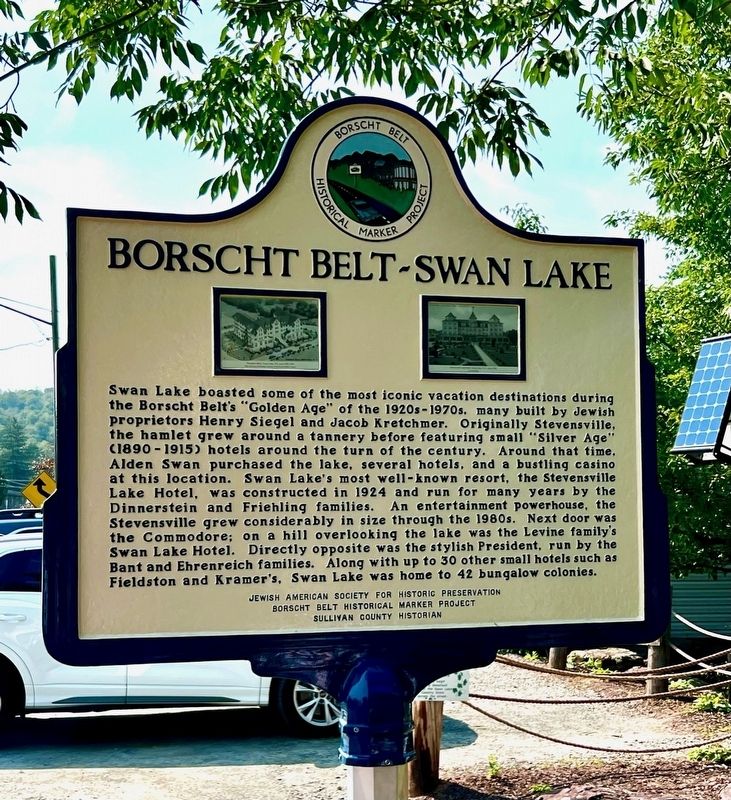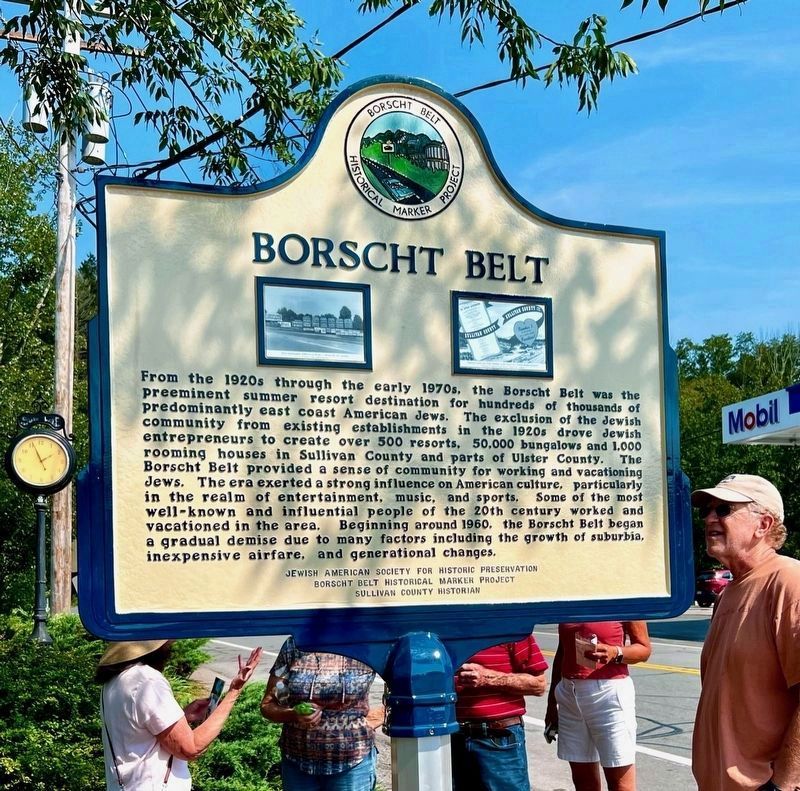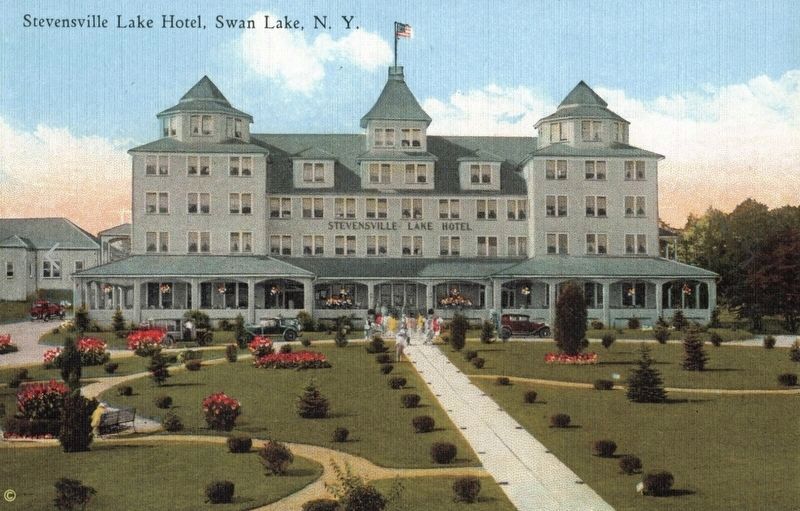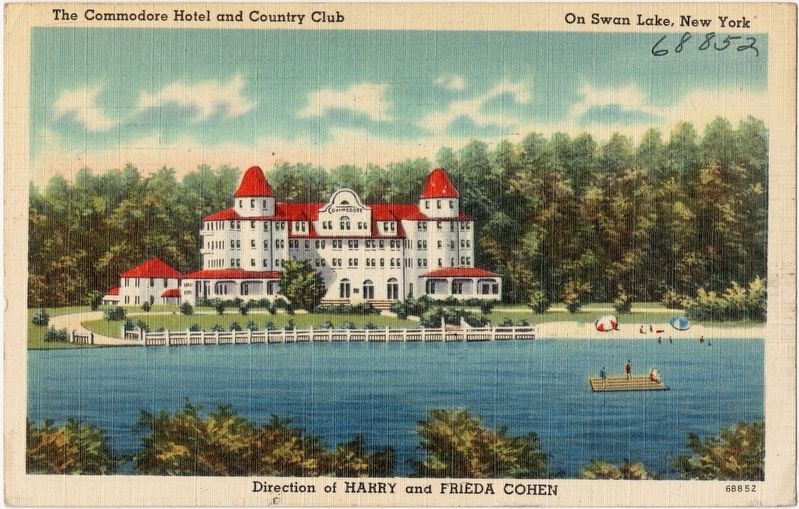Swan Lake in Sullivan County, New York — The American Northeast (Mid-Atlantic)
Borscht Belt - Swan Lake
— Borscht Belt Historical Marker Project —
Borscht Belt - Swan Lake
Swan Lake boasted some of the most iconic vacation destinations during the Borscht Belt's "Golden Age" of the 1920s-1970s, many built by Jewish proprietors Henry Siegel and Jacob Kretchmer. Originally Stevensville, the hamlet grew around a tannery before featuring small "Silver Age"(1890-1915) hotels around the turn of the century. Around that time, Alden Swan purchased the lake, several hotels, and a bustling casino at this location. Swan Lake's most well-known resort, the Stevensville Lake Hotel, was constructed in 1924 and run for many years by the Dinnerstein and Friehling families. An entertainment powerhouse, the Stevensville grew considerably in size through the 1980s. Next door was the Commodore; on a hill overlooking the lake was the Levine family's Swan Lake Hotel. Directly opposite was the stylish President, run by the Bant and Ehrenreich families. Along with up to 30 other small hotels such as Fieldstone Kramer's. Swan Lake was home to 42 bungalow colonies.
Borscht Belt
From the 1920s through the early 1970s, the Borscht Belt was the preeminent summer resort destination for hundreds of thousands of predominantly east coast American Jews. The exclusion of the Jewish community from existing establishments in the 1920s drove Jewish entrepreneurs to create over 500 resorts, 50,000 bungalows and 1,000 rooming houses in Sullivan County and parts of Ulster County. The Borscht Belt provided a sense of community for working and vacationing Jews. The era exerted a strong influence on American culture, particularly in the realm of entertainment, music, and sports. Some of the most well-known and influential people of the 20th century worked and vacationed in the areas. Beginning around 1960, the Borscht Belt began a gradual demise due to many factors including the growth of suburbia, inexpensive airfare and generation changes.
Erected 2023 by Jewish American Society for Historic Preservation, the Borscht Belt Historical Marker Project, Sullivan County Historian.
Topics and series. This historical marker is listed in these topic lists: Entertainment • Industry & Commerce • Parks & Recreational Areas. In addition, it is included in the Borscht Belt Historical Marker Project, and the Jewish American Society for Historic Preservation. series lists.
Location. 41° 45.187′ N, 74° 46.987′ W. Marker is in Swan Lake, New York, in Sullivan County. Marker is on Briscoe Road, on the right when traveling west. Touch for map. Marker is at or near this postal address: 1658 Briscoe Road, Swan Lake NY 12783, United States of America. Touch for directions.
Other nearby markers. At least 8 other markers are within 8 miles of this marker, measured as the crow flies. Hellers Triangle (approx. 3.7 miles away); Spreading Peace and Love (approx. 5.3 miles away); One-Room School (approx. 6.1 miles away); Woodstock Music and Arts Fair (approx. 6.2 miles away); Woodstock (approx. 6.4 miles away); Max and Miriam Yasgur (approx. 7.7 miles away); Last Piece of Yasgur Farm (approx. 7.7 miles away); Site of Toll House (approx. 7.7 miles away).
Regarding Borscht Belt - Swan Lake. 3rd Historical Marker in the Borscht Belt Historical Marker Series, Sullivan County, New York.
Also see . . .
1. Swan Lake (Borscht Belt Historical Marker Project). (Submitted on August 21, 2023, by Jerry Klinger of Boynton Beach, Florida.)
2. A History by Sullivan County Historian John Conway.
In To the Mountains† By Rail, Manville B. Wakefield writes that the local press at the time noted that the property had "great possibilities for development, having a large number of ideal sites for hotels and bungalows." Siegel and Kretchmer took full advantage of those possibilities, constructing the Stevensville and Commodore Hotels side by side on the shore of the lake. With their construction, and the subsequent emergence of the Swan Lake Hotel, the community was poised to enter Sullivan County’s Golden Age.(Submitted on August 21, 2023, by Jerry Klinger of Boynton Beach, Florida.)
The lake itself became the center of media attention on July 31, 1937, when, at the peak of the summer tourist season, a body was discovered floating on the surface of the water. The dead man was soon identified as Walter Sage, a Brooklyn mobster who was running the slot machine operations at various Catskill hotels for organized crime. Sage’s murder was the subject of two spectacular trials in Sullivan County Court, and finally resulted, in 1944, in the conviction of local ne’er do well, Jack Drucker.
3. New Catskill Historical Trail Rekindles Glory Days Of The Borscht Belt.
The broad goal of the Borscht Belt Historical Marker Project is to identify and mark locations emblematic of the history of the Borscht Belt, a celebrated era in American Jewish life.(Submitted on August 21, 2023, by Jerry Klinger of Boynton Beach, Florida.)
4. Forsaken Fotos "Swan Lake" Borscht Belt Area - History NY.
"The name comes from borscht (also transliterated as 'borshch' or 'borsch'), a beet-based soup from the areas of the former Russian Empire that was brought by Ashkenazi Jewish immigrants to the United States, where it remains a popular dish.(Submitted on August 21, 2023, by Jerry Klinger of Boynton Beach, Florida.)
It is a play-on-words of the term "Bible Belt".
Borscht Belt hotels, bungalow colonies, summer camps, and קאָך-אַליינס kokh-aleyns (a Yiddish name for self-catered boarding houses, literally, "cook-alones") were frequented by middle and working class Jewish New Yorkers, mostly Ashkenazi Jewish immigrants and their children and grandchildren, particularly in the 1940s, 1950s, and 1960s. Because of this, the area was also nicknamed the Jewish Alps and "Solomon County" (a modification of Sullivan County), by many people who visited there.
5. Swan Lake Resort Ruins.
Also known as the Stevensville Hotel, Swan Lake Resort sits at 1626 Briscoe Road in Swan Lake, south of Liberty, New York. From the 1920s to the 1970s, New York City Jews flocked to Catskill resorts in the summer months to escape the stifling heat of the city. There were once over 500 resorts and hotels in the area, known as the “Borscht Belt“.(Submitted on August 21, 2023, by Jerry Klinger of Boynton Beach, Florida.)
With increasing religious tolerance and the advent of widespread commercial airliners, many families chose to vacation elsewhere and dozens of these establishments now lay abandoned. An Orthodox Jewish group purchased this particular hotel in 2015, but it remains unused.
Credits. This page was last revised on August 23, 2023. It was originally submitted on August 21, 2023, by Jerry Klinger of Boynton Beach, Florida. This page has been viewed 435 times since then and 140 times this year. Photos: 1, 2. submitted on August 21, 2023, by Jerry Klinger of Boynton Beach, Florida. 3, 4. submitted on August 23, 2023. • Andrew Ruppenstein was the editor who published this page.



